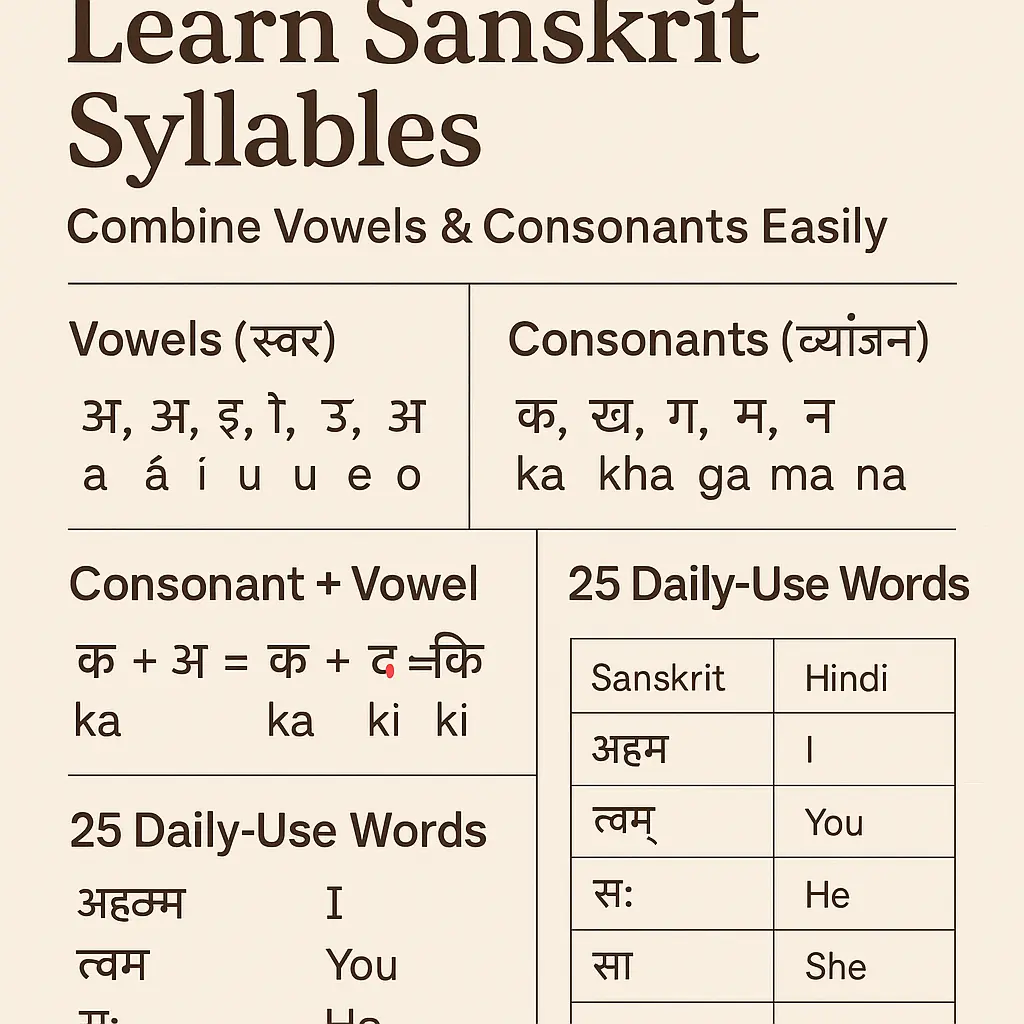Day 2: Combining Letters into Syllables — How Vowels Join Consonants
Welcome to Day 2 of the ASPA Sanskrit Language Program, your step closer to mastering the rhythm of Sanskrit.
Sanskrit is musical, precise, and logical. Every word is built from syllables. When vowels and consonants join, they form the heartbeat of Sanskrit sounds.
Today, you’ll learn to combine letters correctly improving your pronunciation, writing, and reading fluency, while sharpening your brain and connecting you to ancient wisdom.
Why Today’s Lesson Matters
- Cultural Insight: Syllables are the foundation of every mantra and verse.
- Brain Benefits: Combining sounds strengthens memory, focus, and auditory skills.
- Pronunciation Mastery: Speak Sanskrit clearly and confidently.
- Foundation for Words: All vocabulary begins with syllables.
Think of syllables as the DNA of Sanskrit — once you master them, words and sentences come naturally.
Today’s Learning Objective
By the end of this lesson, you will be able to:
- Combine vowels with consonants to form syllables.
- Read and pronounce them correctly.
- Write these combinations neatly with proper matras.
- Recognize how the vowel changes the consonant sound.
Step 1: Quick Recap — Vowels & Consonants
| Vowels (स्वर) | Pronunciation | Example | Meaning |
|---|---|---|---|
| अ, आ, इ, ई, उ, ऊ, ए, ओ | a, ā, i, ī, u, ū, e, o | — | — |
| Consonants (व्यंजन) | Pronunciation | Example | Meaning |
|---|---|---|---|
| क, ख, ग, म, न | ka, kha, ga, ma, na | — | — |
Each consonant carries the “a” sound by default.
Example: क = ka, म = ma, न = na
Step 2: How Vowels Join Consonants
Adding a vowel changes the consonant sound. The matra represents the vowel.
| Consonant + Vowel | Result | Pronunciation | Matra |
|---|---|---|---|
| क + अ | क | ka | — |
| क + इ | कि | ki | ि |
| क + ई | की | kī | ी |
| क + उ | कु | ku | ु |
| क + ऊ | कू | kū | ू |
| क + ए | के | ke | े |
| क + ओ | को | ko | ो |
Tip: Notice matra placement — above, below, or after the consonant.
Visual Chart Example:
क + अ = क क + इ = कि क + ई = की
क + उ = कु क + ऊ = कू क + ए = के
क + ओ = को
Step 3: Practice Flow
- Read aloud slowly and clearly.
- Repeat each syllable 3 times: ka — ki — kī — ku — kū — ke — ko
- Repeat with other consonants: म (ma), न (na), ग (ga)
| म + Vowel | Result | Pronunciation |
|---|---|---|
| म + अ | म | ma |
| म + इ | मि | mi |
| म + ई | मी | mī |
| म + उ | मु | mu |
| म + ऊ | मू | mū |
| म + ए | मे | me |
| म + ओ | मो | mo |
Daily Exercises / Practice Challenge
- Writing Drill: Write each combination 5 times. Focus on matra placement.
- Speaking Drill: Speak aloud slowly, then increase rhythm.
- Mental Drill: Visualize the letter and pronounce in your mind.
- Bonus: Take a new consonant like ग and join it with all vowels.
25 Daily-Use Sanskrit Words
| Sanskrit | Hindi | English |
|---|---|---|
| अहम् (aham) | मैं | I |
| त्वम् (tvam) | तुम | You |
| सः (saḥ) | वह | He |
| सा (sā) | वह | She |
| एषः (eṣaḥ) | यह (पुरुष) | This (male) |
| एषा (eṣā) | यह (स्त्री) | This (female) |
| तत् (tat) | वह | That |
| गृहः (gṛhaḥ) | घर | House |
| विद्यालयः (vidyālayaḥ) | स्कूल | School |
| पुस्तकः (pustakaḥ) | किताब | Book |
| जलम् (jalam) | पानी | Water |
| अन्नम् (annam) | खाना | Food |
| मित्रम् (mitram) | मित्र | Friend |
| मातरः (mātaraḥ) | माँ | Mother |
| पितरः (pitaraḥ) | पिता | Father |
| बालकः (bālakaḥ) | लड़का | Boy |
| बालिका (bālikā) | लड़की | Girl |
| गच्छति (gacchati) | जाता है | Goes |
| पठति (paṭhati) | पढ़ता है | Reads / Studies |
| लिखति (likhati) | लिखता है | Writes |
| खादति (khādati) | खाता है | Eats |
| पिबति (pibati) | पीता है | Drinks |
| उपवेशति (upaveśati) | बैठता है | Sits |
| उत्तिष्ठति (uttiṣṭhati) | उठता है | Stands / Rises |
| स्मरति (smarati) | याद करता है | Remembers |
Oral Practice / Speak Aloud
Practice syllables, words, and sentences aloud:
Syllable Drill:
- ka — ki — kī — ku — kū — ke — ko
- ma — mi — mī — mu — mū — me — mo
- na — ni — nī — nu — nū — ne — no
Simple Words / Sentences:
- अहम् गच्छामि (aham gacchāmi) — I go
- सः पठति (saḥ paṭhati) — He reads
- माता लिखति (mātā likhati) — Mother writes
- बालकः जलं पिबति (bālakaḥ jalaṁ pibati) — The boy drinks water
- मित्रम् पुस्तकं पठति (mitram pustakaṁ paṭhati) — Friend reads a book
Mini Quiz (Oral + Writing)
- Combine क + उ = ? (Answer: कु)
- What is the pronunciation of म + ई?
- Write the Sanskrit word for “Water.”
- Speak aloud: अहम् पुस्तकं पठामि — What does it mean?
- Match: बालकः → ? (Boy / Girl)
Check your answers after speaking aloud and writing — repetition builds mastery.
Motivation & Next Step
You’ve learned the core rhythm of Sanskrit. Every word and mantra comes alive from these syllables.
Consistency builds fluency.
Fluency connects you to culture and thought.
Tomorrow: Learn how to form simple words using these syllables — your first step into Sanskrit conversation.
Read the Previous blog Day 1: Learn Sanskrit for beginners Vowels & Consonants
https://newsarmour.com/sanskrit-for-beginners-day-1/
To avoid searching for the blog every day and get daily updates, exercises, and tips
Sanskrit: A Journey Worth Taking
Sanskrit is more than just words it is a window to timeless wisdom and culture. Each letter you learn, every verse you practice, brings you closer to understanding the soul of our heritage.
Feel inspired? Let this be your stepping stone. Practice a little every day, embrace the learning, and watch yourself grow. Your journey in Sanskrit starts now, and every step counts.
Begin Today. Explore, Learn, Transform.





